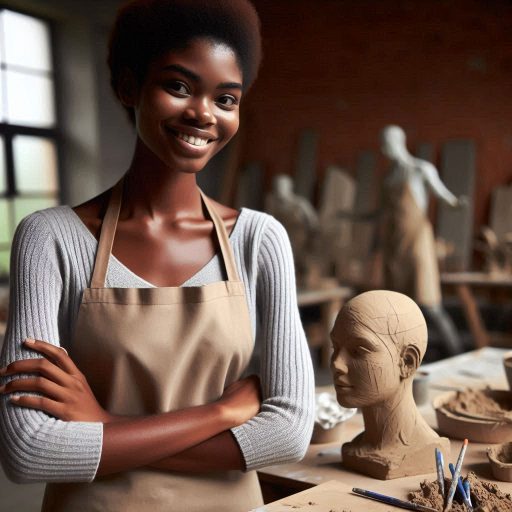Introduction
Printmaking is a form of art where an image is transferred from a plate or block onto paper or another surface.
This allows for the creation of multiple copies of the same design.
Printmaking plays a crucial role in the art world as it allows artists to reproduce their work on a larger scale and make it more accessible to a wider audience.
The history of printmaking dates back centuries, with early examples found in ancient China and Egypt.
Over time, different techniques and tools have been developed, leading to a diverse range of printmaking styles.
Conceptualizing the Idea
Printmaking is a creative process that starts with choosing a concept or idea to express through the medium of print.
Here are the steps involved in this initial stage:
Choosing a Concept for Printmaking
The first step in the printmaking process is to decide on a concept or theme that you want to explore through your artwork.
This could be an emotion, a story, a place, or an abstract idea.
Choose something that resonates with you and that you are passionate about.
Researching and Gathering Inspiration
Once you have chosen a concept, it is important to research and gather inspiration to develop your idea further.
This could involve looking at other artists’ work, studying different techniques, exploring art history, or simply immersing yourself in the subject matter to gain a deeper understanding.
Sketching and Planning the Design
After gathering inspiration, the next step is to start sketching and planning the design of your print.
This could involve creating rough sketches, experimenting with different compositions, and mapping out the elements you want to include in your final piece.
Consider how you want to convey your concept visually and experiment with different approaches to see what works best.
Overall, the process of conceptualizing the idea for your printmaking project is an essential first step that sets the foundation for the rest of the creative process.
Take the time to explore different concepts, research and gather inspiration, and sketch and plan your design to ensure that you have a strong starting point for your final piece.
Read: Understanding Printmaking Editions and Proofs
Selecting the right materials
When it comes to printmaking, choosing the right materials is crucial.
The materials used in printmaking have a significant impact on the final outcome of the print.
Transform Your Career Today
Unlock a personalized career strategy that drives real results. Get tailored advice and a roadmap designed just for you.
Start NowHere are some key considerations when selecting materials for your printmaking project:
Types of materials used in printmaking
- Block Printing: Linoleum or wood blocks are commonly used for block printing.
These materials provide a sturdy surface for carving intricate designs. - Etching: Copper plates are traditionally used for etching due to their durability and ability to hold fine details in the design.
- Lithography: Stones or metal plates are used for lithography.
The smooth surface of these materials helps to transfer the image onto paper. - Screen Printing: Screens made of silk or polyester are used in screen printing.
These materials allow for clean and precise prints.
Paper selection for different printmaking techniques
Choosing the right paper is essential for achieving the desired results in printmaking.
Different printmaking techniques require specific types of paper to achieve the best outcomes:
- Block Printing: Heavyweight papers with a smooth surface work well for block printing.
The paper should be able to withstand the pressure of printing. - Etching: Printmaking papers are ideal for etching, as they are designed to absorb ink and showcase fine details in the print.
- Lithography: Smooth, non-absorbent papers are best suited for lithography.
These papers help to achieve sharp and vibrant prints. - Screen Printing: Lightweight papers with a slight texture are recommended for screen printing.
The paper should be able to hold the ink without smudging.
Tools required for carving or etching
Carving and etching are intricate processes that require specific tools to achieve precise and detailed designs.
Here are some essential tools for carving and etching in printmaking:
- Block Printing: Linoleum cutters, carving tools, and brayers are essential for carving designs into linoleum or wood blocks.
- Etching: Etching needles, scribes, and acid baths are necessary for etching designs into copper plates.
- Lithography: Lithography crayons, tusche, and lithography presses are used to create designs on stones or metal plates.
- Screen Printing: Screens, squeegees, and ink spatulas are the primary tools required for screen printing designs onto paper.
By carefully selecting the right materials for your printmaking project, you can ensure that your final piece turns out exactly as you envisioned it.
Experimenting with different materials and techniques can also help you discover new possibilities and expand your creative horizons in the world of printmaking.
Read: Famous Sculptors: Inspiration and Their Iconic Works
Exploring Various Printmaking Techniques
Printmaking is a versatile art form that offers a wide range of techniques for artists to explore.
Each technique has its own unique qualities and requires different processes to achieve the desired final piece.
Here, we will delve into an overview of relief, intaglio, lithography, and screen printing techniques.
Overview of Relief Printing
Relief printing carves an image into a material. The image remains raised.
Common materials include wood and linoleum.
The raised surface is then inked and pressed onto paper to create the final print.
This technique is known for its bold and graphic quality, perfect for creating sharp images with strong contrasts.
Overview of Intaglio Printing
Intaglio printing involves incising the image into a surface, such as metal or plastic, creating recessed areas that hold the ink.
After the surface is inked, the excess ink is wiped away, leaving ink only in the incised lines.
Press the paper onto the surface to transfer the image.
Intaglio prints feature fine lines and intricate details.
Showcase Your Business Today
Reach thousands of readers actively exploring professional services. Publish your business profile and grow your audience now.
Publish NowOverview of Lithography
Lithography is a versatile technique that relies on the principle that oil and water do not mix.
The image is drawn onto a flat surface, usually a stone or metal plate, with greasy materials.
The surface is then dampened and inked, with the ink adhering only to the greasy image.
The image is then transferred onto paper through a printing press.
Lithography allows for a wide range of mark-making and tonal effects, making it a popular choice for artists looking to create complex and subtle images.
Overview of Screen Printing
Screen printing, also known as silkscreen printing, involves creating a stencil on a fine mesh screen.
Ink is pressed through the stencil onto the printing surface, typically paper or fabric.
Each color requires a separate screen, allowing for vibrant, multi-layered prints.
Screen printing creates bold, graphic images effectively. It excels in commercial printing and apparel design.
Step-by-Step Process of Each Technique
Relief Printing Process
- Design or transfer the image onto the relief material.
- Carve away the negative spaces around the image.
- Ink the raised surface of the relief material.
- Place paper over the inked surface and apply pressure.
- Peel back the paper to reveal the relief print.
Intaglio Printing Process
- Prepare the plate by incising the image into the surface.
- Ink the plate, ensuring the ink fills the incised lines.
- Wipe away excess ink from the surface.
- Place dampened paper over the plate and run it through a press.
- Peel back the paper to reveal the intaglio print.
Lithography Process
- Draw or transfer the image onto a flat lithographic surface.
- Dampen the surface with water.
- Ink the surface, with the ink adhering to the greasy image.
- Print the image onto paper using a lithographic press.
- Peel back the paper to reveal the lithograph print.
Screen Printing Process
- Create a stencil on a mesh screen using a light-sensitive emulsion.
- Place the screen over the printing surface.
- Apply ink to the screen and use a squeegee to push it through the stencil onto the surface.
- Repeat the process for each color, using a separate screen.
- Peel back the screen to reveal the screen print.
Understanding the Differences and Unique Qualities of Each Technique
Each printmaking technique offers a different set of characteristics that appeal to artists for various reasons.
Here are some key differences and unique qualities of relief, intaglio, lithography, and screen printing:
- Relief printing is known for its bold and graphic quality.
- Intaglio printing allows for fine lines and intricate details.
- Lithography offers a wide range of mark-making and tonal effects.
- Screen printing is ideal for vibrant, multi-layered prints.
By exploring and experimenting with these printmaking techniques, artists can expand their creative horizons and discover new ways to bring their concepts to life.
Whether creating bold graphics or delicate details, each technique offers a unique approach to expressing artistic visions in print.
Read: Printmaking Residencies and Scholarships

Creating the printing plate
Carving techniques for relief and intaglio printmaking
Carving is a fundamental part of printmaking.
In relief printmaking, the artist carves away the areas that will not receive ink.
The process involves carving into a surface such as linoleum or wood.
The artist uses tools like gouges to remove material and create the image.
In intaglio printmaking, the artist incises lines or grooves into the printing plate.
This creates recessed areas that will hold ink.
The plate is then inked, and the surface is wiped clean, leaving ink only in the grooves.
Paper is pressed onto the plate to transfer the image.
Overall, carving techniques require precision and attention to detail.
Artists must have a steady hand and patience to create intricate designs.
Preparing the lithographic stone or plate
Lithography is a printmaking technique based on the principle of water and oil not mixing.
The artist draws on the surface with a greasy medium.
The plate is then treated with a chemical solution that fixes the image.
When inked, the ink adheres to the greasy areas and is repelled by the wet ones.
To prepare the lithographic stone or plate, artists must first graining the stone to create a rough surface suitable for drawing.
Next, the stone is treated with a gum arabic solution to make the non-image areas water receptive.
This ensures that the ink only adheres to the image.
Lithography requires a delicate balance of materials and techniques to achieve the desired results.
Artists often experiment with different methods to refine their process.
Screen preparation and emulsion coating
Screen printing is a versatile printmaking method that allows artists to create bold, graphic images.
The process involves transferring ink through a fine mesh screen onto a surface.
To prepare a screen for printing, artists must first stretch the mesh tightly over a frame.
The screen should be taut to ensure even ink transfer.
Next, the screen is coated with a light-sensitive emulsion.
This emulsion hardens when exposed to light, creating a stencil on the screen.
Artists then place a transparency of their design on the screen and expose it to light.
Showcase Your Business Today
Reach thousands of readers actively exploring professional services. Publish your business profile and grow your audience now.
Publish NowThe areas that receive light will harden, while the rest washes away during development.
Screen printing offers endless possibilities for experimentation.
Artists can use multiple screens to create layered effects and vibrant colors in their prints.
Read: Collaborative Projects in Printmaking
Inking and printing process
Once the design is finalized on the printing plate, the next step is inking and printing.
This process requires precision and attention to detail to ensure a high-quality final piece.
Mixing Ink Colors and Consistency
Before applying ink to the printing plate, it’s essential to mix the right colors and achieve the desired consistency.
This step is crucial in determining the overall look and feel of the final print.
Applying Ink to the Printing Plate
Once the ink is prepared, it’s time to apply it to the printing plate.
This process involves carefully spreading the ink evenly across the surface of the plate, making sure not to miss any details of the design.
Using a Printing Press or Other Methods for Transferring the Image onto Paper
After the ink is applied to the plate, the next step is transferring the image onto paper.
Use a printing press or other methods for results.
Choose the method based on your desired outcome and resources.
A printing press applies consistent pressure to the paper. This results in a clear, crisp print.
Professional printmaking studios use this method for precision. It ensures efficiency in production.
For those without access to a printing press, other methods like hand-printing or using a DIY press can also be effective.
These methods may require more manual labor but can still produce impressive results with practice and attention to detail.
Regardless of the method used, the key to a successful printing process lies in meticulous attention to detail.
From mixing ink colors to applying them to the plate and transferring the image onto paper, each step plays a crucial role in creating the final piece.
By following these steps carefully and with patience, printmakers can bring their vision to life and produce stunning prints that captivate audiences.
The inking and printing process transforms a concept into art.
It makes a tangible piece that people can admire.
The artwork becomes something cherished for years to come.
Discover More: Building a Strong UX/UI Designer Resume
Editioning and artist proofs
In the world of printmaking, editioning plays a crucial role in ensuring the value and uniqueness of each print.
Let’s delve into the significance of creating limited editions, the process of signing and numbering prints, and the purpose of artist proofs for experimentation.
Importance of creating limited editions
- By creating limited editions, artists can establish scarcity and exclusivity, increasing the value of their prints.
- It also ensures that the artist’s work remains collectible and maintains its quality over time.
- Collectors often prefer limited editions as they are seen as more valuable and desirable than open editions.
- Establishing a limit on the number of prints also allows artists to maintain control over their work and avoid oversaturation in the market.
- Limited editions can create a sense of urgency among buyers, encouraging them to make a purchase before the prints run out.
Signing and numbering prints
Once the artist decides on the edition size, they sign each print.
They also number each print to show authenticity and position.
Signing the print is usually done in pencil below the image, while numbering is placed on the opposite side.
The signature adds a personal touch and connection between the artist and the buyer, making each print unique.
The numbering follows a specific format, typically written as a fraction (e.g., 3/50 indicates the third print out of an edition of 50).
Artists include the print title in the margin. They add the creation year and relevant details.
Making artist proofs for experimentation
Artist proofs are extra prints from the main edition.
They test various techniques and experimentation.
They allow artists to explore variations, color schemes, and other modifications before finalizing the edition.
Artist proofs hold more value than regular prints. They reveal the artist‘s creative process and experimentation.
These proofs can serve as valuable insights into the artist’s vision and artistic development, providing a glimpse into their creative journey.
Some artists may choose to keep artist proofs for themselves or offer them as special editions to collectors and patrons.
Overall, editioning and artist proofs are essential aspects of the printmaking process that contribute to the overall value, authenticity, and creativity of the artworks produced.
By understanding the importance of creating limited editions, signing and numbering prints, and making artist proofs for experimentation, artists can enhance their practice and engage with collectors and art enthusiasts on a deeper level.
Showcase Your Business Today
Reach thousands of readers actively exploring professional services. Publish your business profile and grow your audience now.
Publish NowEvaluating the final piece
After completing the printmaking process, it is crucial to evaluate the final piece to ensure it meets the desired quality standards.
This involves quality control checks and making any necessary adjustments to improve the overall outcome.
Quality control and making adjustments
- Inspect the final print for any imperfections or flaws that may have occurred during the printing process.
- Check for color accuracy, registration, and overall consistency in the print.
- Assess the clarity and sharpness of the image to ensure it meets the intended vision.
- If any issues are identified, make necessary adjustments to correct them before finalizing the piece.
Comparing proofs and final print
- Compare the final print to the proofs that were created during the printmaking process.
- Look for any discrepancies between the proofs and the final print, such as differences in color or image clarity.
- Ensure that the final print accurately reflects the initial concept and design that was intended for the piece.
- If there are significant differences, investigate the cause and make adjustments as needed.
Seeking feedback from peers or mentors
- After evaluating the final piece on your own, it can be beneficial to seek feedback from others.
- Show the print to peers or mentors who have experience in printmaking or art to gather their input.
- Ask for constructive criticism and suggestions for improvement to further enhance the final piece.
- Consider all feedback received and make any additional adjustments based on the recommendations provided.
By thoroughly evaluating the final piece, implementing quality control measures, comparing proofs, and seeking feedback from peers or mentors, you can ensure that your printmaking project reaches its full potential and achieves the desired outcome.
Conclusion
Reflecting on the journey from concept to final piece, it is evident that printmaking is a complex and rewarding process.
Each step, from developing an initial idea to refining the final print, requires patience, skill, and dedication.
Importantly, experimentation and practice are crucial components of printmaking.
Trying out different techniques, materials, and methods allows artists to discover new possibilities and refine their skills.
Through trial and error, artists can push the boundaries of traditional printmaking and create innovative and unique pieces.
As we encourage readers to explore printmaking techniques, we also encourage them to express their creativity through this art form.
Printmaking offers a versatile and dynamic platform for artistic expression, allowing artists to convey their ideas, emotions, and perspectives in a visually captivating way.
Whether you are a seasoned printmaker or a newcomer to the art form, there is always something new to learn and discover.
By immersing yourself in the world of printmaking, you can unleash your creativity, challenge yourself, and create beautiful and meaningful works of art.
[E-Books for Sale]
The Big Book of 500 High-Paying Jobs in America: Unlock Your Earning Potential
$19.99 • 500 High-Paying Jobs • 330 pages
Explore 500 high-paying jobs in America and learn how to boost your career, earn more, and achieve success!
See All 500 High-Paying Jobs of this E-Book
1001 Professions Without a Degree: High-Paying American Jobs You Can Start Now
$19.99 • 1001 Professions Without a Degree • 174 pages
Discover 1001 high-paying jobs without a degree! Unlock career tips, skills, and success strategies for just $19.99!




